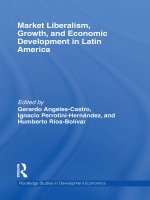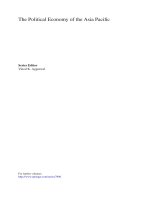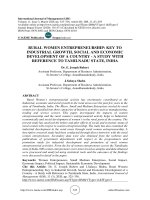Economic growth and economic development 255
Bạn đang xem bản rút gọn của tài liệu. Xem và tải ngay bản đầy đủ của tài liệu tại đây (102.77 KB, 1 trang )
Introduction to Modern Economic Growth
5.7. Sequential Trading
A final issue that is useful to discuss at this point relates to sequential trading.
Standard general equilibrium models assume that all commodities are traded at a
given point in time–and once and for all. That is, once trading takes place at the
initial date, there is no more trade or production in the economy. This may be a good
approximation to reality when different commodities correspond to different goods.
However, when different commodities correspond to the same good in different time
periods or in different states of nature, trading once and for all at a single point
is much less reasonable. In models of economic growth, we typically assume that
trading takes place at different points in time. For example, in the Solow growth
model of Chapter 2, we envisaged firms hiring capital and labor at each t. Does
the presence of sequential trading make any difference to the insights of general
equilibrium analysis? If the answer to this question were yes, then the applicability
of the lessons from general equilibrium theory to dynamic macroeconomic models
would be limited. Fortunately, in the presence of complete markets, which we assume
in most of our models, sequential trading gives the same result as trading at a single
point in time.
More explicitly, the Arrow-Debreu equilibrium of a dynamic general equilibrium
model involves all the households trading at a single market at time t = 0 and
purchasing and selling irrevocable claims to commodities indexed by date and state
of nature. This means that at time t = 0, households agree on all future trades
(including trades of goods that are not yet produced). Sequential trading, on the
other hand, corresponds to separate markets opening at each t, and households
trading labor, capital and consumption goods in each such market at each period.
Clearly, both for mathematical convenience and descriptive realism, we would like
to think of macroeconomic models as involving sequential trading, with separate
markets at each date.
The key result concerning the comparison of models with trading at a single point
in time and those with sequential trading is due to Arrow (1964). Arrow showed
that with complete markets (and time consistent preferences), trading at a single
point in time and sequential trading are equivalent. The easiest way of seeing this
241









